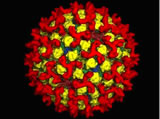Development of a vaccine for bluetongue virus
Published: 1 December 2014
With the support of a BBSRC Industrial Partnership Award, Prof Palmarini has been working in collaboration with Merial Animal Health on a synthetic biology approach for a vaccine platform against known and newly emerging serotypes of Bluetongue Virus.
 With the support of a BBSRC Industrial Partnership Award, Prof Palmarini has been working in collaboration with Merial Animal Health on a synthetic biology approach for a vaccine platform against known and newly emerging serotypes of Bluetongue Virus.
With the support of a BBSRC Industrial Partnership Award, Prof Palmarini has been working in collaboration with Merial Animal Health on a synthetic biology approach for a vaccine platform against known and newly emerging serotypes of Bluetongue Virus.
Bluetongue is a major infectious disease of ruminants. Effective vaccines exist for certain serotypes of BTV, however, there is little or no cross-protection between different serotypes. Therefore, a BTV outbreak caused by a new serotype requires the production of a new vaccine.
In collaboration with Merial, the Palmarini lab has devised a novel vaccine platform which facilitates vaccine production against current and newly emerging BTV serotypes. The platform is based on “synthetic” viruses in which the outer core proteins of different BTV serotypes are incorporated into a common tissue-culture adapted backbone. Overall, this vaccine platform will significantly reduce the time taken from the identification of new BTV strains to the development and production of new vaccines, as the viral genomes of these viruses can be entirely synthesised in vitro. A patent protecting the IP of these products has been filed by Merial Animal Health.
Prof Palmarini will continue to work with Merial Animal Health to apply the same technology to the design of synthetic vaccines for African Horse Sickness Virus. This work is supported by the Horserace Betting & Levy Board.
The advent of synthetic biology approaches and the development of reverse genetics systems, has allowed the rapid and reliable design and production of pathogen genomes which can be subsequently manipulated for vaccine production. Within the CVR we have extensive experience in the application of reverse genetics to engineer viruses. This technology can be used in a number of applications:
- To develop live attenuated vaccines and/or inactivated DIVA vaccines;
- To attenuate virus replication, for example by deleting virulence genes or preventing viral reassortment;
- To express foreign genes, for example in DIVA vaccines or multi-valent vaccines.
First published: 1 December 2014

